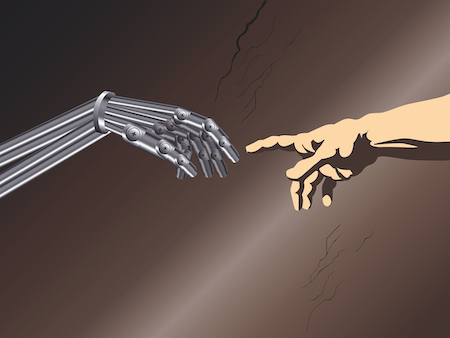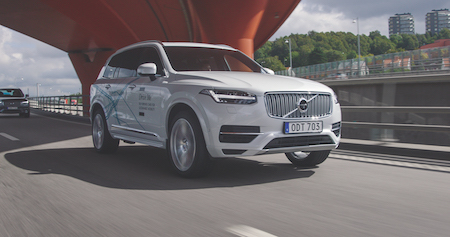By Tim Pinto media and IP lawyer, Taylor Wessing
Since the earliest cave paintings, visual artists have used tools and materials to express themselves. This constant evolution includes use of paint, brushes, cameras, printers, computers, and more recently tablets and mobile devices. In such cases, the artist has always been at the centre of the work and its creativity. But as with all other areas of technology, the evolution of art is now encompassing artificial intelligence (AI). AI in art hit the headlines in October 2018, when a portrait produced using AI was sold at a Christie's auction in New York for over $430k (smashing the initial estimate of $7k-$10k).
From a legal perspective, copyright and moral rights are the main rights which enable artists to be rewarded for their work, incentivise them and protect their intellectual creations from being exploited without consent. In this two-part article, we explore how these rights apply in the context of increasingly powerful and prevalent artificial intelligence.
Machine learning and neural networks
Traditional software operates by reference to a pre-determined set of rules which produce a predictable outcome for a given input. The programmer writes the code (i.e. rules) which dictates what the machine does. In machine learning, the machine can be said to work out for itself how best to process information following a training period. These machines may be “neural networks”, which have multiple complex connections, inspired by the human brain.
Supervised learning
The two main types of machine learning are "supervised learning" and "unsupervised learning". In supervised learning, the machine is given a set of inputs (examples) and the trainer gives feedback on which outputs are desirable or not desirable. The machine learns by adjusting the weightings within the network or algorithm, until it becomes skilled at producing correct outputs with a sufficiently high degree of probability. For example, by feeding numerous images of cats into the system, the machine learns to recognise cats with a high degree of probability, which would be more difficult to achieve by trying to write strict rules on what all cats look like from every angle. In the art world, a machine could be trained to recognise whether or not a painting is a Picasso, for example.
Unsupervised learning
In unsupervised learning, the machine determines patterns by itself within large data sets, without the programmer necessarily knowing what these are, nor dictating what outputs are desirable. For example, by feeding data from multiple artworks into a machine, the machine may learn how to produce a style or a new artwork based on those inputs.
With AI-generated art, the artist often cannot predict with certainty what the output work of art will look like. For example, artist Pierre Huyghe's recent "UUmwelt" exhibition at the Serpentine Gallery in London is partly based on data from fMRI scans of the brain activity of individuals given certain descriptions.The data was fed into a deep neural network which attempts to visually represent it on screens. However, the actual output on the screens is also dictated by the conditions within the gallery, including light, temperature, humidity, the presence of a community of live flies and the visitors themselves. As Huyghe explains "…what is made is not necessarily due to the artist as the only operator…".
The human "hand" and levels of AI
In order to analyse the intellectual property dimension of AI-generated art, it's worth distinguishing between the different levels of human and machine artistic input.
Machine as slave.
Where the human uses the machine merely as an assistant as part of an artistic endeavour. In such cases, the output is determined completely by the artist based on deterministic rules. For example, when the artist David Hockney uses an iPad to "paint" digital images, the machine is a tool to replace paper and brushes.
Machine as collaborator.
Where the artist uses a deep learning system trained by machine learning. The user is not normally able to predict the specific output for any given input. However, the human artist is still in charge of the overall creative endeavour. The human will choose the algorithm and inputs with which to train the machine and/or select the output which comprises the final artwork.
Machine as artist.
Here, the artwork is produced by the machine without any human artistic creativity or authorship. It may be that the machine taught itself and selects which works to display. It appears that this type of AI is currently the domain of science fiction, but it is interesting to consider it from a legal perspective.
Consideration of AI by reference to levels of human/AI input is not unique to the sphere of art. In fact, the levels of human/AI input affect the discussion of all applications of AI. For example, it is standard in the field of autonomous vehicles to consider levels 0-5 of machine/human control. Level 0 being where the car has no autonomous functionality. The responsibility and liability of the driver/user, manufacturer, owner and/or insurer may vary depending on the level under which the vehicle is operating. (Here we surely have a nascent field of law, liability and litigation.)
The analogy is apposite in graduating the extent to which the human and the machine are in control of and responsible for the output (whether it be an artwork or autonomous driving). But there are differences. The goal of art generation is generally to produce a new creative image which was not necessarily precisely predictable and may or may not be constrained by rules. Such is the nature of creativity. In contrast, the goal of the autonomous vehicle, which continually has to process masses of constantly changing and complex data, is to drive safely and predictably from A to B in adherence with the rules of the road, and without surprising or endangering the driver or other road users.
Deep Dream Generator: Razorbill example
One of the machine learning tools which can produce new images from an existing image is the Deep Dream Generator (deepdreamgenerator.com). I uploaded a photograph of a Razorbill on a rock, which I took with my phone on the Isles of Scilly. I randomly selected a style option and some settings. I had to wait a few minutes for the resulting images to appear. See the centre and right hand images below, with the original photo on the left. To what extent are these two new images the result of my own artistic creativity and/or that of others? Is this a version of Type 2 AI, or another level? Who owns the copyright (if any) for the new works? The same issues generally apply to other types of AI-generated work, such as robo-journalism, robo-movies and robo-music.
Copyright originality – EU v UK tests
Since 1988, the UK's Copyright, Designs and Patents Act has stated who the author of AI-generated artistic works is:
- S. 178 "computer-generated", in relation to a work, means that the work is generated by computer in circumstances such that there is no human author of the work".
- S. 9(1) …“author”, in relation to a work, means the person who creates it.
- S. 9(3) In the case of an artistic work "which is computer generated, the author shall be taken to be the person by whom the arrangements necessary for the creation of the work are undertaken".
Whilst it is impressive that UK legislation had included provisions relating to such technically advanced works, this doesn’t mean it has all the answers. Before considering authorship, and by extension ownership, it’s important to determine whether and when copyright subsists. If there is no copyright in the first place, there is little point in analysing its ownership.
Subsistence of copyright
The UK Act sets out the basic requirements for copyright in artistic works:
- S. 1(1) – Copyright is a property right which subsists … in … (a) original … artistic works…
- S. 4(1) … “artistic work” means — (a) a graphic work, photograph, sculpture or collage, irrespective of artistic quality…
UK originality
Thus, in order to qualify for UK copyright protection of artistic works, the work must be "original". The traditional test for originality under English law is that the work must satisfy two conditions. First, it must originate from the author and not have been copied. Second, it must result from sufficient skill, labour and judgment. Only a modest (not insubstantial) degree of skill, labour and judgement is generally needed. English copyright law has traditionally protected relatively mundane works, such as football coupons, lists of football fixtures, railway timetables, shorthand reports of speeches and 25-letter grids for newspaper competitions.
EU originality
The above common law traditional test for originality can be contrasted with the Continental tradition of protecting an author's personality. In general, the former is more based on an economic rational of reward and/or incentivising creativity, whereas the latter is more based on an author's personality rights (as exemplified by moral rights).
Under EU copyright law, two conditions must be satisfied for something to be classified as a "work" under the InfoSoc Directive 2001/29, which gives authors the exclusive right to authorise or prohibit the reproduction, communication to the public and distribution of their works.
According to the CJEU:
First, the subject matter concerned must be original in the sense that it is the author's own intellectual creation…Secondly, only something which is the expression of the author's own intellectual creation may be classified as a "work"…": Levola Hengelo v Smilde Foods (Case C-310/17; 13 November 2018).
The EU test for originality in the context of photographs (a category of artistic work) was set out by the CJEU in Painer v Standard Verlags (Case C-145/10)1, namely:
-
the work must be the author's own intellectual creation (AOIC)
-
it must reflect the author's personality
-
this is the case if the author was able to express his/her creative abilities by making free and creative choices
-
the author stamps the work with his/her "personal touch".
Which test applies in the UK?
Whilst the UK is a member of the EU, it must interpret any harmonised principles of copyright law in accordance with EU law. In SAS Institute v World Programming [2013] EWCA Civ 1482, the English Court of Appeal recognised that the EU test (which requires the author's own intellectual creation) appears to be a higher threshold than the traditional English test of skill, labour and judgment.
It appears that the test in EU countries for originality for the purposes of subsistence, as well as infringement, is the intellectual creation test. It’s possible to argue that the EU test for originality only applies to authors' exclusive rights under the InfoSoc Directive (i.e. in the context of infringement) and not to subsistence of copyright (i.e. whether a work is protected in the first place). However, that is a fairly fine distinction and unlikely to be accepted if tested before the CJEU. This debate may of course become academic in the UK after Brexit. In the second part of this article, we will draw conclusions on originality and explore authorship and infringement.
1. Following the CJEU's judgment in Infopaq v Danske Dagblades (Case C-5/08) in relation to the author's own intellectual creation test.


.jpg)
.jpg)
.jpg)

.jpg)

.jpg)

.jpg)
